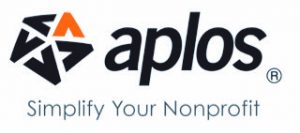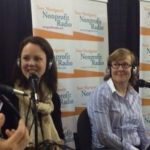
Patty Breech: Best & Worst Of Newsletters

Patty Breech returns with the most common email marketing mistakes and how to make your print or digital newsletter stand out. She’s CEO of The Purpose Collective.
Amy Frame: Digital Self-Care

Here’s help to identify the digital spaces that bring you stress and joy, and realization of the pitfalls of multitasking. Amy Frame also has advice on resilience against online harassment. Amy is from Win Without War.
These both continue our coverage of NTEN’s 2023 Nonprofit Technology Conference, #23NTC.
Listen to the podcast
Podcast: Play in new window | Download
Get Nonprofit Radio insider alerts!I love our sponsor!
Donorbox: Powerful fundraising features made refreshingly easy.
We’re the #1 Podcast for Nonprofits, With 13,000+ Weekly Listeners
Board relations. Fundraising. Volunteer management. Prospect research. Legal compliance. Accounting. Finance. Investments. Donor relations. Public relations. Marketing. Technology. Social media.
Every nonprofit struggles with these issues. Big nonprofits hire experts. The other 95% listen to Tony Martignetti Nonprofit Radio. Trusted experts and leading thinkers join me each week to tackle the tough issues. If you have big dreams but a small budget, you have a home at Tony Martignetti Nonprofit Radio.
View Full Transcript
Processed on: 2023-04-28T14:52:40.757Z
S3 bucket containing transcription results: transcript.results
Link to bucket: s3.console.aws.amazon.com/s3/buckets/transcript.results
Path to JSON: 2023…05…638_tonymartignetti_nonprofit_radio_20230501.mp3.763837471.json
Path to text: transcripts/2023/05/638_tonymartignetti_nonprofit_radio_20230501.txt
[00:01:38.84] spk_0:
And welcome to tony-martignetti non profit radio. Big non profit ideas for the other 95%. I’m your aptly named host of your favorite abdominal podcast. And oh, I’m glad you’re with me. I’d be thrown into hemo pneumothorax if you made me hyperventilate because you missed this week’s show. Best and worst of newsletters. Patty breach returns with the most common email, marketing mistakes and how to make your print or digital newsletter stand out. She’s CEO of the purpose collective and digital self care. Here’s help to identify the digital spaces that bring you stress and joy and realization of the pitfalls of multitasking. Amy frame also has advice on resilience against online harassment. Amy is from win without war. These both continue our coverage of N ten’s 2023 nonprofit technology conference on Tony’s Take two. It isn’t what it is. We’re sponsored by donor box with intuitive fundraising software from donor box. Your donors give four times faster helping you help others. Donor box dot org. Here is best and worst of newsletters.
Welcome to tony-martignetti non profit radio coverage of 23 N T C. The nonprofit technology conference in Denver, Colorado. It’s actually, welcome back. And this is our final interview of 23 N T C with me is Patty Breach. She is founder and CEO of the Purpose Collective. And here at 23 N T C, we are sponsored by Heller consulting technology strategy and implementation for nonprofits Patty Breach. Welcome back to nonprofit radio. Thank you so much for having me. Last year. I was telling you off Mike that I loved your suggestions about the welcome journey and I implemented them [00:02:24.48] spk_2:
myself. I’m so glad to hear that [00:02:36.13] spk_1:
I did for the insider alerts for nonprofit radio. Insider alerts when people sign up, I had a three, I have three email. I still have a three email journey all based on your [00:02:36.97] spk_2:
advice. Thank [00:02:39.00] spk_1:
you. So this year we’re talking about the best and worst of nonprofit newsletters. I guess you’ve seen some bad ones. [00:02:47.98] spk_2:
I hate to say that I have [00:03:05.62] spk_1:
you have obviously because we got the best also. So um let’s start because I don’t want to end on a down note. Um apply learnings to email messages, decided newsletter style. Alright, maybe let’s start with you. You have avoid the most common email marketing mistakes. All right. And you’re welcome to pepper it with good and bad examples. Sure. The bad ones are probably funnier than the good ones. So if you have some good funny one, good, funny, bad ones. Um, what are some common email marketing mistakes? [00:03:54.48] spk_2:
Yeah, so I would say a really big one that I see a lot is when organizations um use really complicated words and they use really like dry professional sounding tone and they have a lot of industry jargon and a lot of acronyms in their email. So I think an email should be written, a newsletter should be written the way we talk. It should be very conversational. It should be like a six to an eighth grade reading level. And unfortunately, what’s common in a lot of newsletters that I see is to kind of throw in words like infrastructure and like government spending on key performance indicator. And it’s just like that kind of, that kind of information isn’t absorbed. [00:04:23.75] spk_1:
People feel they have to show up in a certain way. Where do we get that from? They don’t talk like that, they don’t talk like that. Where does that come from? That is college English courses that teach you to write a thesis or something? [00:04:27.83] spk_2:
Yeah. Or maybe just after writing grants, you think that you need to use the same type of language. But your average supporter um wants to hear from you in a laid back conversational, easy to understand tone. Okay. [00:04:44.51] spk_1:
Thank you. What’s another marketing [00:05:37.37] spk_2:
mistake? Another one, this is, is a big run. I see a lot of organizations use what I call we focused language. So they tend to talk a lot about themselves and it’s completely understandable why they do that. Um You know, you wanna, you wanna show your donors what you’ve been up to and you want to prove that you’re a really good organization doing really good things in the world. Um Unfortunately, though, it can come across as really self centered if you’re just sending an email out that says here’s what we did. Um And it doesn’t really invite your supporter into the story and show them that they have a role there. So the solution to that is to use you focus language and to really say to the donor, you know, thanks to your support, here’s what we were able to do. Your gift changed the world in this way. Um So you’re, it’s the content is still the same. You’re still talking about what the organization has done, the impact the organization has had. But it’s a shift in the language so that the reader feels like they’re part of the story, they feel like they’re part of the movement. They feel like they matter that their support is really important. Um can really draw people in a lot more. [00:05:58.01] spk_1:
I found a lot of times when I’m writing, I, I adopt this one. Exactly. I, I try to replace the with you, like maybe the outcome or replaced with the outcome you enabled, you know, you can, you can get that pronoun in there a lot if you’re conscious about being you focus. [00:06:30.56] spk_2:
Yeah, I feel like I’m a broken record. Sometimes I say this all the time. Like the most important word you can use in any of your marketing is the word you. And I told that to um the people in my session today. I was like, if you forget everything else, I tell you today, just remember this, like the word you the most important one. What [00:06:38.66] spk_1:
else? I’m sure you have other email marketing mistakes. [00:07:43.67] spk_2:
Um Yeah, so another one that I see is that people are sending organizations are sending emails that don’t stand out from the rest. So, um all of us at this moment in time probably have quite a few emails in our inbox that we’re not really looking forward to reading. Like it’s a long block of text. Um It’s probably about something, some topic that we’re not exactly looking forward to reading every word. Um And so I would really encourage nonprofits to make sure that they’re presenting their information in a way that’s inviting and easy to consume. So make sure that there’s enough line breaks to break up your text to make sure that you’re highlighting portions of the text, either with just bold font or hyperlink. Um If you can add photos and buttons in for calls to action, that’s great. I like to picture someone um checking their email on their phone while they’re pumping gas and if they pull up an email and it’s just a full block of really long text at the gas station, they’re not going to read it. Um, whereas if it’s a little bit more inviting and paragraphs, [00:08:15.45] spk_1:
even single sentence paragraphs, that’s where you can violate the rules. We were taught in English, English composition class. There should be no single, a single sentence should never be a paragraph. Wasn’t that one? Like and donate sentences with prepositions, you know, the two you can donate to. Um, um, but yeah, I mean, you can have a single sentence, paragraph. I use them a lot and yeah, so dense blocks. I like your uh gas station. I don’t know, analogy or a gas station setting. I’m busy with something but I’ll also, I’ll engage if it [00:08:23.43] spk_2:
looks inviting, right? You have some of my attention. Are you going to pull me in and get the rest of my attention because it’s really inviting? Okay. [00:08:30.33] spk_1:
Okay. Yeah. What else? Mistake? [00:10:54.60] spk_2:
Another big one is that organizations don’t tell a story in their emails. And so they, they often just assume that, you know, why you should give a donation. Um I had a couple examples of organizations that just said things like, um please donate to our operating funds before the end of the year. That was it? Or please help us reach our year end goals. And it’s like, what do you do? Why should I give you money? You set a goal that doesn’t mean I should contribute to it. You have a fund. Why should I write about it? And so another thing too is that, you know, you’re probably not the only organization that this donor is receiving an email from like there’s people getting, you know, maybe three or four, maybe 14 or 15 different emails. And so be careful assuming that the donor remembers what you do remembers your cause, remembers everything about it, remembers why it’s important to give you want to tell that story in each email. And I really recommend telling the story from the perspective of one person, one individual. So um the example I gave was it was actually a perspective of an animal. One donkey um is the story of his donkeys rescue and how he’d been rehabilitated. And um we as human beings a lot easier for us to wrap our minds around a story of one individual’s struggles and triumphs than it is for us to wrap our heads around a bunch of statistics. So um it can be tempting to say, you know, look at our impact we’re in, we’ve helped this many thousands of people and we’ve reduced pollution by this many parts per billion or whatever it is. But those really don’t sink in with us as much as hearing like um here’s a child who used to cough a lot, but now he doesn’t like now he can breathe freely and run around. All thanks to this new stove that his family put in, thanks to your support, you know, like things like that are much easier for us to follow. So I really recommend telling a story in your emails as much as you can every time. And that might be a story from the perspective of one of your team members. It might be a story from the perspective of one of your community members. Um Whatever it is, we love stories, we eat them up. [00:12:16.41] spk_0:
It’s time for a break. Stop the drop with donor box, the online donation platform. Let me ask how many putative donors drop off before they finish making the donation on your website. You can stop the drop and break that cycle with donor boxes. Ultimate donation form added to your website in minutes. When you stop the drop, punitive donors become donors. It’s fourth time faster, checkout easy payment processing. There’s no set up fees, no monthly fees, no contract. And I love this. You will be joining over 40,000 U S nonprofits and over 50,000 worldwide. Now, if I had said there were four using donor box, you might say, well, they could be making big mistakes, all four of them. That’s, you know, tiny number. It’s a lot of bad practice out there. But 50,000 around the world they can’t all be wrong. So there’s something going on here. Donor box helping you help others. Donor box dot org. Now back to best and worst of newsletters with Patty Breach. [00:12:23.91] spk_1:
Have you got any good uh good bad newsletter examples? Maybe maybe you pepper maybe, maybe included a couple but any, any anything that stands out deserves a shout out alone as a, as a bad newsletter. [00:14:03.41] spk_2:
Um Yeah, I mean, so one that comes to mind it was actually very beautifully designed email. There’s like a gorgeous photo in it and then there’s a short little paragraph and a call to action button, but that was an email that said, you know, the year is coming to a close. Let’s end it on a, on a grateful note. Will you donate to our operating fund? And that was the end of it, didn’t say, will you donate to provide more clean water? Will you help us house more people? Nothing, no indication of what it was for. So that one comes to mind as being like too little information. There’s another one that I think had too much information. Um It was for a, a community that had been affected by a natural disaster. And so it was a really long dense text, heavy email and there was one sentence that was hyperlinked in the middle of it. So that was the one thing that you’re I was drawn to. Um but the sentence that was hyperlinked wasn’t exactly, it wasn’t a call to action. It wasn’t, it didn’t draw the reader to the right part of the email. And so I thought that the most important part of that email was if you’ve been affected by this natural disaster, here’s click here to get the support that you need or even if you want to help those affected by the disaster, click here to provide that help, but that’s not what was highlighted. It was like an announcement that the government had created a task force to do something related. So [00:14:26.18] spk_1:
remember vague and okay. Okay. Um Any other, I don’t wanna give short shrift to your, your content, your your value. So anything else other common email marketing mistakes? [00:15:00.88] spk_2:
Um I mean, I could talk about this for hours. I’m trying to think of the ones that I put. Um I would say in terms of that, um wanting to be inviting and wanting people to stand out from the rest subject lines can be really important. Um So I would not recommend having a subject line that says like spring 2023 newsletter. Um Yeah, [00:15:01.82] spk_1:
that’s pretty obvious. I mean, it doesn’t right. There’s no value [00:15:27.21] spk_2:
in that. Like, why, why should I read this? Especially if I have six other emails in my inbox that tell me their spring newsletter, you know, you’re not standing out from the rest at this point. So I think um putting a subject line that that pulls something from the email body, but that’s like really interesting like, um like, hey, I’d really like to tell you the story about so and so or life changing stories like these are possible because of you like putting stuff like that in the subject line. It’s more intriguing you in there. You got the, you in there and now you have, you’ve piqued my interest. I’m like, oh, what life changing stories, like stories, [00:15:54.84] spk_1:
at least give yourself the best shot. And spring newsletter is not going to do it. Right. Okay. Right. All right. Pull out something interesting. Provocative. Uh, all right. All your content is not necessarily going to be provocative, but at least interesting. not, I mean spring 2023 newsletter. That sounds like the name of the file dot doc. That, that’s your file name. Stay away from that. Stay away from [00:16:14.81] spk_2:
that. All [00:16:16.91] spk_1:
right. Fair enough. Anything else bad. [00:17:34.39] spk_2:
Yeah, I guess one other, one other one is um information overload. So just trying to cram 24 pieces of information into one newsletter. Um You run the risk of people not absorbing anything if you try to get them to absorb too much. Um So I used an example of an email that was from like a local voting organization trying to encourage people to get their ballots in and letting them know that, you know, certain deadlines are coming up. And I really think this in from this email was information overload. And so the main point of like it’s too late to mail your ballot and please drop it off at one of these locations by this date. I think that was lost in the sea of all this other information that was being thrown at you in like multiple columns and multiple colors and multiple. There was also like, do you want to come on a ballot processing tour center tour? Do you know a 17 year old who needs to register to vote? Do you want to watch this video we made about? And it was like, it’s just too much. So you miss the most important thing. And so I always recommend try to just have 2 to 4 pieces of information in your email newsletter if you can and don’t go past that. [00:17:37.18] spk_1:
Tell me about the purpose collective. What are you doing over there? [00:18:00.78] spk_2:
Yeah. So we’re a digital marketing consulting firm. Um There’s three of us and all three of us actually used to work for an organization that was based in Nepal. We had a really unique challenge um being in Nepal with us organization. So the donor base was in the US and Europe. And we had to basically convince people who had never visited our project site and had never met any of these people, had to convince them to care enough to donate to them. And all we had was the internet to do it. So we learned a ton about how to write compelling emails and blog posts and social media posts. And we decided to take what we learned there and help other organizations see that same kind of success [00:18:25.95] spk_1:
based in Boulder Colorado, but nationally, [00:18:30.72] spk_2:
yes, I’m in Boulder Colorado. And my other two team members are elsewhere. [00:18:56.57] spk_1:
You’re in Boulder. Okay. But not the other. Doesn’t matter, it doesn’t matter where they are. We’re all over. Alright. Alright. Purpose collective um decide on a newsletter style. I’m just looking at your learning objectives. I’m not imposing this on you. It was, it was public, it was public um public domain decide on a newsletter style. It’s best for your organization that culture based uh know your donor type. How do you decide? [00:19:36.48] spk_2:
Yeah, it’s a great question. Um I think of all the different things we talked about. You know, like, do you feel like you could tell stories in your newsletter each month? Um Do you feel like that is maybe not the right fit for your organization because you do have a lot of important announcements to get out to people. Um If so, can you send fewer emails or sorry, more frequent emails with fewer pieces of information per email? So you’re not overloading people. Um And the main thing I would suggest to people is to test things out. So test a newsletter style that’s different than the one you have now and see if it performs better. Um And just keep iterating on that, keep trying different things. Keep saying, does this style work better than this one? Is this one more easy to consume than that one? Until you find something that feels both easy for you to produce? And that really resonates with your supporters, [00:20:06.46] spk_1:
improve impact, apply learnings to email marketing, to improve impact. Do we really cover [00:20:13.40] spk_2:
that? I think we did. Yeah, I mean, I would just say, you know, there’s a lot of really wonderful organizations out there doing such important work in the world but their newsletters don’t often reflect that [00:21:03.41] spk_1:
some of your newsletters. Oh, no, no, no, this does not apply to your exemplary, but he still has ideas that you’re all, your newsletters are all above average. So, no, there’s always learnings to be had. Hopefully your newsletters don’t suck. But if you feel like it does, yours does, then, you know, do something about it. I mean, if it doesn’t get much engagement, right. If you have buttons and nobody’s clicking them, if you have asks and nobody’s responding, these are symptoms of a sucking newsletter [00:22:17.50] spk_2:
and to go back to that newsletter, that was about the natural disaster. It’s totally understandable to think, you know, oh, there’s so much going on after this disaster struck. Let’s just get a newsletter out and we’ll worry about the formatting later. But I would actually argue that that’s when, when the format of your newsletter matters most because you’re trying to communicate with people who have just gone through a really rough time and they might be, you know, a single mother with three Children under the age of five or someone who doesn’t have English as their first language and they’ve lost their home because of this natural disaster and they’re living out of a hotel room. And if you send them an email, that’s really hard to understand. It’s a really dense block of text and it’s not easy for them to see that your organization can help them. Um It’s a missed opportunity. So it’s, it’s, you’re gonna have more impact as an organization, you’re going to be better at fulfilling your mission. If you can get the information to the people who need it really effectively through your communication channels. So this isn’t just about like creating a pretty email because I think you should. It’s about reaching the people who need you, leave it there. [00:22:44.23] spk_1:
All right, she’s Patty Breach founder and CEO of the Purpose Collective. Thanks very much, Patty. Good to see you again. Thanks for all your valuable ideas. Thanks for having fun to thank you and thank you for being with nonprofit radio coverage of 23 N T. See where we are wrapping up. This is our last interview of the conference and where we are sponsored by Heller consulting technology strategy and implementation for nonprofits. Thanks so much for being with us. [00:25:31.48] spk_0:
It’s time for Tony’s take two. It is what it is, it is what it is. I’ve been avoiding that for a while now because there are so few things that it applies to like hurricanes, um cyclones, volcanoes, tornadoes, cloud formations. Alright. Those are all weather related, but it makes the point that there are so few things that just they are what it is, they are what they are, the problem with this. It is what it is is ubi ubiquitous phrase that folks use is that it absolves the responsible people or person of their responsibility and the responsible party might be you. Lots of times I say it is what I made it but whoever it is. Yeah. So I just don’t like this avoiding responsibility. You know, there’s so much on Twitter about um accountability, transparency. I guess we’re talking mostly about accountability here. So hold people accountable. It is what it is holds nobody accountable. It is what it is just gives up. There’s nothing we can do. There’s nothing I can do nothing you can do. There’s nothing they can do. There’s nothing anybody can do. It is what it is. But there’s so few things that, that applies to like weather is the only thing I can think of. There may be some very other small circumstances, narrow circumstances, but it is what it is does not apply to anywhere near the circumstances that we attach it to. So I have dropped as much as possible. It is what it is. And when people say it, I say, well, you know, that absolves everybody of responsibility that, that means that nobody made that happen. But let’s take a look at it because because of what it is, someone obviously did it. So it is what it is. That’s how, that’s how I feel about it, think about it. And that is tony stick to. We’ve got boo koo but loads more time here is digital self care. [00:25:56.03] spk_1:
Welcome back to tony-martignetti non profit radio coverage of 23 N T C 2023 nonprofit technology conference in Denver, Colorado. We are sponsored at the conference by Heller consulting technology strategy and implementation for nonprofits. With me now is Amy Frame director of Data and Technology at Win Without War. Amy. Welcome to Nonprofit radio. [00:26:04.96] spk_3:
It’s wonderful to be here. Thank you for having me. It’s my [00:26:07.09] spk_1:
pleasure. Your session topic is digital self care and healing for digital professionals. Um ordinarily, I would ask why this session is important. I think it’s obvious but, but I still want you to frame it for us, please. [00:26:45.00] spk_3:
Yeah, I think it’s really important as folks come and we learned so much about how to use tools, how to use technology for the folks that we serve, how to fundraise. And it’s really important to take a step back and look at how the technology that we spend our entire lives sort of immersed in affects us, how it affects our emotions. You know, whether we have healthy habits around it and how we can make our own lives better while using technology. [00:26:56.91] spk_1:
And you say in the title for Digital Professionals, isn’t everybody a digital professional? [00:27:03.01] spk_3:
Yes. Yeah, in some ways but not [00:27:06.09] spk_1:
intended just for just for like developers and [00:27:38.88] spk_3:
no, no, absolutely not. I think anyone who works, whether you’re a fundraiser, whether you’re writing emails, no matter what you do in this space, you are interacting with technological systems, but you’re also following sort of the conversations that happen about technology, the conversations that happen around the tools you use or the issues that you might work on. And some of those issues are very hard homelessness, poverty. I work in war and genocide, very difficult topics. And so I think anybody can kind of benefit from doing this kind of self reflection. [00:27:45.90] spk_1:
So you uh as part of your session, you had, you’ve done your session already [00:27:51.74] spk_3:
know we’re doing it tomorrow, [00:27:52.88] spk_1:
coming up tomorrow. Okay? You have a mapping exercise. Yeah. Is there any way that our listeners can benefit from that exercise? Oh, yeah, absolutely. They can they access it [00:29:57.72] spk_3:
online but it will be in our collaborative notes. I can describe it. It’s actually very easy. Please do, please. You basically you take a piece of paper and you think about all of the places that you go online and you need to exclude the things you have to do for work. So you can’t say the work slack, right? You have to be on the work slack. You don’t have a choice. But for instance, if you are in a Facebook group with family members or you follow cooking on Instagram or you do for me like foreign Policy, Twitter. Right. And be pretty specific about the places you spend online and include places that you lurk that maybe you don’t type a lot, but you read a lot. So like celebrity news, things like that. And once you’ve done that, take two color pens, red and a green one, if you want to be like traditional and all of those places where you feel bad or you feel that it’s toxic or you feel like you see conversations that, you know, are negative primarily circle those with the red pen and then the places that make you feel really good and like maybe it’s art you’ll enjoy or maybe it’s somebody who makes really cool videos or it’s a good conversation place for you circle those in green and then really look at those and start thinking about how do I have less of the red space in my life and how can I get, spend more of my time in those green spaces or find places like that? So that not spending 50% of my time online in spaces where people might be abusive or, you know, any political discussion. Let’s be honest at this point, online in this country is very fraught and difficult and imagine what your world looks like if you don’t go to those spaces anymore. And sometimes that’s really hard, like leaving Twitter is a big thing or, you know, one thing that came out when I’ve done this exercise with coworkers. And when Colleen and I did it together just to get ready for the presentation was that extended family? Facebook for a lot of people is a terrible place. And that’s a hard thing to say to your family. Like, look, Uncle Steve, I can’t talk to you on Facebook anymore, but you might end up having a better relationship with that person if you set that limit. Right? Sometimes [00:30:24.20] spk_1:
you don’t have to go as far as extended family on occasion. Um Okay. So this is, this is a very simple exercise. Your right. Thank you. But it’s consciousness raising, it’s awareness, it’s presence, you know, thinking about, yeah, being conscious about your choices, your online choices. [00:31:36.26] spk_3:
Yeah. And I think sometimes, and especially for people who kind of work in tech, we kind of already know we should do these things, but we never actually make time to reflect and make the choices to do them and it becomes just, it actually becomes another source of digital stresses. I really, no, I should go clean up my Twitter account and then that’s another to do list thing that I’m not getting done, right? And so it’s just like making time to evaluate those things and like honor yourself a little bit and recognize that all of those toxic things on the internet. I think tech people sometimes think I can describe it. So I’m immune to it, but we’re, it’s, we’re not immune to it. All of the, you know, negativity, all of the manipulation that happens like and through advertising and stuff that all works on us too. And so we have to, we have to treat ourselves like regular users and not the and not make the assumption we’re different than other people who are using like the technology that we build or the content we put out. We have to recognize this all we are all part of the ecosystem as users also. Well said, [00:31:37.40] spk_1:
alright. Um you have a, you have an exercise quick, uh there’s a quick exercise unpacked the pitfalls of multitasking, multitasking, right? Alright. So before we, before we get to that six hour topic, um anything more on our just our consciousness and being more um more intentional about our online choices, I [00:32:06.22] spk_3:
would say that, you know, what we really hope that people take away from this is that these seem these, these are things that seem sort of like common sense, but they’re not useful to us. If we don’t actually take time to do that, there’s not [00:32:27.96] spk_1:
nothing wrong with like a simple exercise like old school and that is kind of simple to do. I mean that doesn’t, that doesn’t mean it’s not valuable, you know, we were last session we were just talking about, I guess I was just talking about handwritten notes, you know, like for stewardship for donors, how uncommon they are, but how they stand out because hardly anybody does them anymore and their handwriting, handwriting notes goes back 400 years or something. [00:32:47.25] spk_3:
That right. [00:33:29.72] spk_1:
Exactly. Exactly. So, yes, your grandmother’s tactics. Uh, she didn’t call them tactics but they’re not just because they’re old doesn’t mean they’re without value. Those two are not, do not, one does not imply the other. All right, you said it. I just had to amplify it. Get tired of the old school. No. No, you can’t. There’s, there’s no value in that because it’s old. Yeah. Well, it lasted for a long time and it still survived. Maybe for a good reason. I’m not saying everything old, nor am I saying everything old is valuable still. I’m not saying that either. All right, I can feel my blood pressure rising. All right, I’m sorry. Okay. You were making a point. Um um No, we haven’t gotten to know we’re still talking about being in your intentional choices, [00:34:27.27] spk_3:
making your intentional choices and making time and making that investment in yourself. It makes you do better work when you’re not stressed out. I think one of the dangers of being in online places and we just absorb so much negativity is that if you work in, you know, in the nonprofit industry, you need to be optimistic, to do good work, right? You need to have hope, you need to have positivity or you’re, you’re not gonna feel like what you’re doing is really matters, right? And so it’s, it’s about like you know, pushing away that negative because it can make people angry and cynical and bitter. And there’s a whole larger story of how things are playing out in our country right now over all of this, right, being able to pull yourself back from that and be one of the people who is working from positive spots, working from that optimism is really, really important if we want to solve our problems, if we want to do good work, if we want a nicer world to live in and then that’s real. [00:34:43.43] spk_1:
Do the exercise, pay attention to the red circles, try to try to amplify the [00:34:50.17] spk_3:
green. There it is. And that’s just as simple as that. Let’s [00:34:56.64] spk_1:
move to multitasking. So we are generally poor multitaskers, [00:35:00.70] spk_3:
right? We are very, very bad multitasker. [00:35:03.49] spk_1:
I don’t know. Do you have data is there? I [00:35:39.48] spk_3:
will say the one thing that struck out to me when I was looking at multitasking and you know, there’s numbers about, you know, how slow your attention span or this or that. If you want a really potent statistic about how bad we are at multitasking. 3500 ish people died in 2021 because they were looking at their phones when they drove. That’s a real stat and that is just shows how hard it is and it’s really hard. Everybody does it. I’m just going to look for a second. I’m gonna talk while I’m driving. We’re just not built for that and, and, you know, that’s, you know, but it’s hard when you that in the moment, the way that our phones are designed to, like, hit that dope. I mean, it is hard to be like, okay, I’m gonna pull over for a minute. Right. It is. I’ve been [00:36:04.53] spk_1:
trying to do that more and I’m not, you know, I’m trying to ignore the call pull over when I can and make the call back. If I, if I need, if I can’t wait till I get to my destination. But I’m trying to do more of that pull over. [00:36:06.44] spk_3:
It’s very hard, you know, and it is this sort of psychology of the devices that we use, you know, and half the time I’ll be like frantic [00:36:54.62] spk_1:
things are made to dopamine hits damn things. Did you see social network? Is that the one that, is that the one about Facebook social dilemma? The documentary, a social dilemma, social dilemma. The one that deconstructs the social platforms to show you how they give you dopamine hits like like the three circles on an iphone when the other person is typing. Oh my God, they’re typing. I can’t leave. I can’t go somewhere else. I might miss the message. I might not see it as soon as it comes through like that. There’s, there’s a one of the streaming services has a documentary. I don’t know. Is it social dilemma? [00:36:56.65] spk_3:
I think that might be what I think I might have seen this. But, yeah, it is. It’s all right there. Right. [00:37:01.45] spk_1:
Yeah, they’re made to keep you invested in it. Right. [00:37:19.67] spk_3:
Exactly. And half the time, you know, I’ve noticed that, you know, if I’m driving and I hear it and then you pull over whatever and it’s just like a notification from some app that I barely use and I don’t care about. Right. But it’s easy. But nonetheless, you’re like, I have to see what this is. I need to look at this. [00:37:48.41] spk_1:
That’s a good one about notifications. That’s another place where we could be intentional. Go go to your settings and find, look at notifications, whatever kind of phone you have and look at, do you need notifications from all the apps that you have it turned on for? Okay, Google Maps, I would say notifications. They are good. You’re getting turn by turn directions. But do you need to know that somebody I liked your post on linkedin wasn’t even a comment. It was a like, you know, be scrupulous about that ship. [00:38:04.86] spk_3:
Do you need, do you need to know about that? Uber eats coupon, you know, right now, and that one is particular pet peeve, lots of notifications, but you know, that kind of stuff and, and, and you can also set those settings a lot of times you can customize them. So I only want an important this, you know, this kind of notification or that kind of notification. So it [00:38:15.82] spk_1:
could be a silent one. It could just be a banner without the noise. And I know iphone and that’s the one I had for years that it’s very, it’s very detailed about whether you get a sound or not. So you could just get a banner notification. So it’s not going to disturb you while you’re driving. [00:40:05.65] spk_3:
Right. Right. Because then you won’t even notice it, you know. And so, you know, all of that stuff, you know, the driving is bad, but just in general, I think what gets lost when we try to multitask and I, you know, I work with people who swear they are the best multi, I see it in job listings, right? Like be a good multitasker. But if you’re trying to write that email blast and make it great, but you’re also having three conversations on slack, you’re not actually writing a great email and you can tell yourself you are. But if you give yourself the gift of focus, you’re going to do better work. And like again, the work that the people at this conference do, the work that non profit people do is important. It deserves to be done well and it’s okay to say to your co workers. And this is for, I’ll be honest, for us, organizationally, this was something we all had to work on together, which was we’re going to, if someone says I’m busy and I’m not going to respond to you on slack for an hour, the rest of us need to respect that, right? And, and creating that space and, and making it so that people know it’s okay. So when you’re working in your collaborating with people, letting them also letting them know, you know, I know you’re busy, you’re working on this event. You know, why don’t you, you know, touch back with me when you’re available and giving that to other people to write and making sure they know it’s okay that you, that you don’t have to be responded to urgently because I think we’ve in, in the sort of environment we live in since we always have a phone, we assume everything is urgent, right? But you’re not doing good work. If you do everything urgently, some work takes thought and planning and plotting, you know, [00:40:12.92] spk_1:
you know, set boundaries and respect boundaries. Exactly. Respect your own. So like enforce your own but also respect other people’s boundaries. Exactly. [00:40:22.79] spk_3:
Exactly. Alright. [00:40:55.96] spk_1:
So multitasking. Yeah. And it’s right and you can feel it, you know, if you’re, I don’t know, I shouldn’t impute my feelings, other people. So I won’t do that. I feel like when I attempt to multitask it might be like I’m trying to listen to something on youtube and I’m also writing and I can tell I’m not doing it well. So I’ll shut the youtube thing off. But I can tell I’m not focused, I can tell you do feel it. And then, but so, you know, if you get those feelings, um, you know, don’t, don’t kid yourself respect your own feelings. If it doesn’t feel right, you’re probably not giving either one justice, not learning how to build the deck on youtube. And that wasn’t what it was probably something political. I was trying it on youtube and you’re not giving respect to the, the thing you’re trying to write on the screen. [00:41:36.72] spk_3:
You know, and, and also, I mean, there’s an element to it and I think that as phones have become so pervasive that we’ve forgotten it that it’s, if I’m sitting in a meeting with you and I’m reading my phone, I’m telling you, you’re not that important, like, and we, you know, it’s very disrespectful but it’s become really, really common for people to do that and, and, you know, respect other people’s time, respect your time and, and really, you know, especially when we’re talking about, you know, co workers and working together, like we all only get 40 hours a week to get the job done, like, make that easy for everybody around you as well, you know, because [00:41:53.85] spk_1:
this can contribute to burnout. Yeah. Yeah. Burnout departure, [00:42:04.03] spk_3:
all of that. Yeah. And it makes feel, it makes people feel like they’re not important in your organization and that definitely, you know, it does, it makes people feel burnout, it makes people feel undervalued, it makes people feel not valued, you know, [00:42:11.94] spk_1:
where else would you like to go with this uh self care healing wellness? I [00:43:25.06] spk_3:
think, you know, the, the other thing that, um you know, I would add to this is, you know, if you find doing setting limits for yourself really hard, then you need to think about some more creative strategies. And I will say that this doing these things and I sort of developed this out of working with my co workers who were clearly very burnt out with technology and we work with, you know, a lot of times we deal with abusive people and things like that. And I would say, you know, for me, it was really hard to put down the phone or to put, and my, the worst was I had spent all weekend online and I finally had to realize that I had to put my laptop in a closet for a Sunday on Sundays. That’s what I do. And it seems it makes me feel like an absolute child, but I have, it actually gets the job done. It makes me feel better. I started people think I’m crazy for saying this, but I go places and I don’t take my phone all the time anymore. If I’m going to a movie, I don’t need my phone. You know, if I’m gonna go have a drink with friends, I don’t need my phone and I started leaving it and it initially feels very like almost dangerous. But what if something happens, but emergencies happened before there were phones like thing, you know. And I think so [00:43:34.89] spk_1:
initially it feels dangerous. [00:43:37.17] spk_3:
It did, it was [00:43:38.06] spk_1:
very stressful, but after a couple of weeks now [00:44:12.75] spk_3:
it feels great. Yeah. Yeah. And now, and now I have places I’ve built inhabits too. I have places, I don’t take my phone. I have places where I always have my phone and that, and you can build those habits around you. But sometimes you do need to be sort of a little bit tough with yourself and a little bit more drastic with yourself. But, you know, at the end of the day, I think, you know, one of the most important, you know, sort of underlying maxims of self care is you’re worth the effort, right? Like having a good mental headspace, being efficient, feeling good, you know, you’re worth it. And I think sometimes, you know, it’s, it feels like it’s too much and indulging ourselves is easier, but that’s not really the case. Indulging ourselves doesn’t always make us happy in the end. And so, you know, sometimes you do have to be a little, a little tough with yourself and sometimes you got to be a little bit a little bit radical with your lifestyle. You know, you [00:44:35.92] spk_1:
have ideas around resilience against online harassment. [00:46:14.32] spk_3:
Yeah. Um, and we do talk about this some in the thing, both Colleen and I, um, work in, in areas where there are a lot of trolls, a lot of abusive people. Um You know, I did some work in gun violence prevention and people will, like, put, people will put up a picture of your house from Google Maps. Like it’s, they’re scary people and there are people who just want to suck away your energy and make you feel bad. And I think, you know, the first thing is just just, there’s never any payoff to engaging with people like that. And sometimes you just get mad and you’re like, I’m gonna get that guy, right? And you wanna start arguing with him, it never pays off to argue that, that a lot of times that person is just doing nothing and it’s very sad but they’re sitting and doing nothing all day but bugging other people online, right? You know, so it never ever, ever pays off, you know, and, and also like, when you’re seeing stuff like that, like me, as much as, like we all complain about the job that platforms do moderating content, it doesn’t get taken down if we don’t report it and it doesn’t get identified as a trend if people don’t report it and use those systems and it takes time and it feels sometimes I feel like it has an element of I’m telling the teacher on you, but really that the way that technology works needs people to report bad behavior. Um and so that it can identify it and cut it off faster and get rid of users who are terrible. You know, and then, you know, the other thing is, yeah, you know, at the end of the day, if people are genuinely threatening, you should always take whatever action you need if you need to call the police because somebody’s threatened, threatening you do it like your safety is the most important priority. And there are, you know, there are dangerous people, unfortunately out there, most of the time, the people who are asking you aren’t dangerous but you know, they’re on the side of your own safety. I would say. Yeah. Yeah. [00:46:41.27] spk_1:
Yeah. Anything else on the self care and healing that we haven’t talked about that you are going to Yeah, [00:47:24.85] spk_3:
I would say else, you know, the last thing is, you know, we’re in this great space and, you know, we haven’t been able to be at NTC for a couple of years and people are doing it virtually now. And I loved when we had virtual space when I went to it last year. And, but, you know, as you’re, as you’re coming out of these spaces and you’re developing these, you know, professional skills. You know, this is another set of tools that you should develop and you should be working on because, you know, we don’t, we can’t do good work if people get burned out. If people leave the industry because it’s too stressful, it’s too taxing. And so, you know, make this part of your sort of professional development journey is, is really watching yourself finding the things that trigger you online and staying away, getting away from those red spaces and really like, you know, finding the places of community and those green spaces that will sustain you and keep you being able to, you know, do the good work that you do. [00:47:48.14] spk_1:
Amy Frame director of Data and technology at Win without War. Amy. Thank you very [00:47:54.04] spk_3:
much. Thank you. It’s been an absolute pleasure. [00:48:01.79] spk_1:
Thank you. I enjoyed it and you had a lot of value for listeners to thank you. Thank you. Thank you. And thanks to our listeners for being with nonprofit radio coverage of 23 NTC, the nonprofit technology conference where we are sponsored by Heller consulting technology strategy and implementation for nonprofits [00:49:09.50] spk_0:
next week. Quiet quitting and what to avoid when selecting a CRM if you missed any part of this week’s show, I beseech you find it at tony-martignetti dot com. We’re sponsored by Donor Box with intuitive fundraising software from donor box. Your donors give four times faster helping you help others donor box dot org. Plus, there’s the 50,000 users worldwide nonprofits users worldwide. Our creative producer is Claire Meyerhoff shows. Social media is by Susan Chavez, Mark Silverman is our web guy and this music is by Scott Stein. Thank you for that affirmation. Scotty B with me next week for nonprofit radio. Big nonprofit ideas for the other 95% go out and be great.

 Do you know that a big email list may be worse than a smaller one? Have you got ghosts or zombies in your lists? This all matters if you want your emails to land in inboxes instead of junk. Judy Freed, from
Do you know that a big email list may be worse than a smaller one? Have you got ghosts or zombies in your lists? This all matters if you want your emails to land in inboxes instead of junk. Judy Freed, from 









